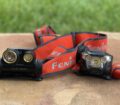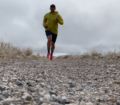- Overall Design: 4.50
- Weight: 4.0
- Durability: 4.0
- Value: 4.75
[facebook]
I wasn’t too late to the Apple scene. I started adopting their technology in 2007. That doesn’t exactly make me an earlier adopter; missing that mark by 20 years or so. But since jumping on board I’ve had 3 iPods, MacBook, MacBook Pro, Mac Pro, iPad, iPhone 3, 3s and two iPhone 4’s. Some have come and gone given my needs at the time while others been lost or stolen. With a background in technology, I’ve pushed these devices and learn a lot about them. Mostly I’ve learned enough to say, I’m sticking with Apple. They are just too far ahead of anything at this point to even consider the alternatives. Maybe another manufacturer will catch up but until then I’m sticking with what works… almost perfectly.
I’ve found the iPhone 4 to be a great companion in support of my trail running, ultra marathons and training.
Here are the Positives:
1. Music – I don’t listen to music on the trails very often but on those rare occasions the iPhone is fantastic. Using a pair of iPhone compatible headphones allows you to listen to music, turn the volume up or down, pause songs, forward through songs and answer incoming calls. It’s about as safe as listening to music on a trail can be.
2. Finding Trails – By using the Trails.com application I get leads on where to find trails in areas we travel. I don’t subscribe to Trails.com so I don’t get trail mapping but just locating the trails has worked well. It gives us the opportunity to pinpoint places we want to travel to. Generally, no trails equals no go unless we have a really good reason to visit a place. One example was during our drive across Georgia. While we were driving the timing was about right to stop for a run before we hit Atlanta during rush hour. We pulled up the iPhone Trails.com app and found a good looking trail only 5 or 6 miles off I-20. After using Google maps on the phone we could see there would be ample parking for the motorhome so we made our way to the trail. It turned out to be a great place to run and we hung out a couple of extra hours afterward once we knew the traffic would be cleared.
3. Tracking Runs – as we have previously reviewed, I like using the LogYourRun.com iPhone app. It’s been as accurate as I need to give me good feedback on my distance, time and elevation. If you run mostly in one area you generally know the distances, your average time and elevation but as we travel we never have this luxury.
4. Compass – I had many occasions in Lake Tahoe where I needed the compass. The trails in Lake Tahoe turn into a spaghetti network anywhere there are houses nearby a trail. Even people who live there have a hard time reading a map and telling you which way to go. I would take the trail topo map and compass app running on the iPhone then sync them to north. From there I would try to get on the right trail looking for distinct geographic clues or signs along the way. In the cases where I had a cell signal, I would mark my starting point as a pin drop on Google Maps and as I was returning I would use Google Maps in compass mode to help confirm if I was getting closer the start or if I was moving in the right direction (not accurate on switchbacks and trails circumnavigating around ridges).
5. Google Maps – as already mentioned above Google Maps, when a cell signal is available, it’ll confirm your location.
6. Run Calculator – these applications allow you to translate time and distance into pace or solve for any third variable when you know the first two.
7. Weather Access – Lots of applications that help in planning your running. We used them to move to new locations around the country, plan which days to run and even plan the exact time that would be best.
8. Photography – having the iPhone allows you to document trails without a separate camera. And with the picture quality it can do a very remarkable job.
9. Emergency Access – where there was a cell signal, ever so slight, your one step closer to help if you need it.
If you add up the ways in which the iPhone comes into play they can replace:
Guide books and maps, a camera, a compass, iPod, GPS tracking devices and watches… all in one easy to carry package.
On top of all this the battery life is good. By turning off blue tooth and wifi, along with turning down the screen brightness I never had the battery even get close to draining even with constant GPS tracking.
I’ve had no issues with it malfunctioning after getting wet from sweat. The encasement has help up well against water.
I know that other Android devices have similar applications but given the vetting process of Apple combine with the feedback system I feel more comfortable that this platform provides more stability in the tools.
The Negatives of the iPhone:
1. If you need to use the screen and it’s wet from sweat it can be hard to use and hard to see. And during a good workout you rarely have anything clean enough or dry enough to clean the screen.
2. Cost for plans. We pay a lot for unlimited voice, text and data. Without data many of the apps wouldn’t work and without voice it’s not going to help you in case of an emergency.
It’s hard to find too many faults with the phone even as I try. The iPhone has turned into an indispensable tool in my running and training and I’m happy to carry it with me.


















I had an iPhone 4 I used for running. Water got in through the headphone jack (I perspire profusely) and made the phone speaker and cameras inoperative. Speaker phone worked, and headphones continue to work. I still use it, but now it’s just an iPod Touch with a built-in GPS. :/